P182 Special Edition - One of the best cases gets better
by Joshua Buss on April 12, 2007 1:00 AM EST- Posted in
- Cases/Cooling/PSUs
Interior
Inside, not much has changed through the various iterations of Antec's P18x series. Their design places the power supply at the bottom but does not invert the motherboard like other cases with this layout. Although sometimes this can make certain motherboard/power supply combinations impossible fits for the case, Antec believes it is still worthwhile it to have this layout, and for a few reasons it really does make sense.
Most notably, the design allows for all the hottest air that collects around the CPU and motherboard power regulators to be taken away very quickly by the two large exhaust fans placed at the top-rear of the case.
In this shot of the fan in the top plate, a USB-powered flexible work light is visible. When not in use, the light stores away in its holder. It's an interesting inclusion, but of course it's only useful if the system is powered on; this is generally not the case when people are working on the interior of their computer.
Unlike the P180 we reviewed earlier, the entire inside of the P182 SE is black - right down to the drive cages and motherboard mounting tray. To hold the hard drives, two separate removable cages are used. The top unit can contain two drives, each one in its own removable sled, and the bottom cage can hold four with vibration-dampening rubber grommets.
Each cage is guided securely in place along rails and held fast with a single thumbscrew. As for the power supply, it's held with a piece of metal with rubber along some of its edges that goes around three sides and then fastens with screws onto a platform underneath. Four more screws can go into the PSU itself in the back, regardless of which way the unit is oriented - a nice touch a lot of cheaper cases still have not implemented.
Our Zalman PSU's plethora of cables still all fit through the collapsible opening, but longer power supplies might require the removal of the fan in this bottom section. For the longest power supplies, the entire plate that the fan mounts onto can be taken out. The handy sliding cover serves to keep the cabling neat, and simultaneously it segregates the different airflow zones of the case; unfortunately it's still a bit flimsy in its construction and use. There are actually two holes in the cover, one for the power supply cables and one for cabling to go to the lower hard drive cage. Both can be opened and closed individually.
Inside, not much has changed through the various iterations of Antec's P18x series. Their design places the power supply at the bottom but does not invert the motherboard like other cases with this layout. Although sometimes this can make certain motherboard/power supply combinations impossible fits for the case, Antec believes it is still worthwhile it to have this layout, and for a few reasons it really does make sense.
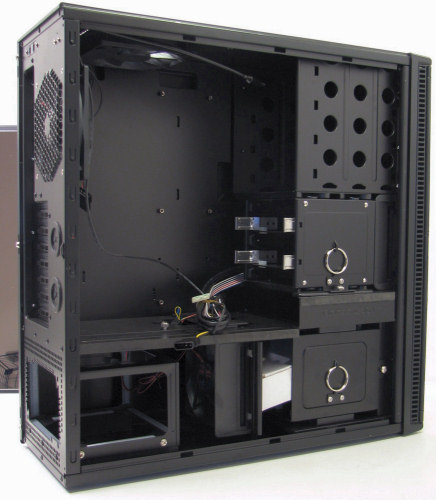 |
| Click to enlarge |
Most notably, the design allows for all the hottest air that collects around the CPU and motherboard power regulators to be taken away very quickly by the two large exhaust fans placed at the top-rear of the case.
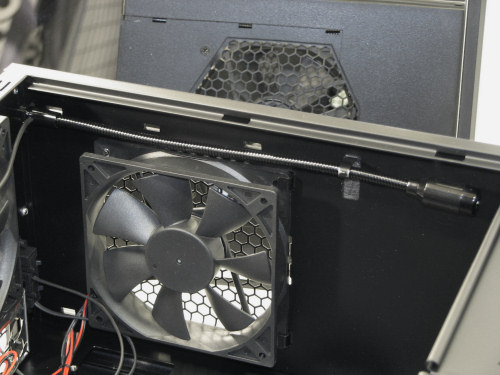 |
| Click to enlarge |
In this shot of the fan in the top plate, a USB-powered flexible work light is visible. When not in use, the light stores away in its holder. It's an interesting inclusion, but of course it's only useful if the system is powered on; this is generally not the case when people are working on the interior of their computer.
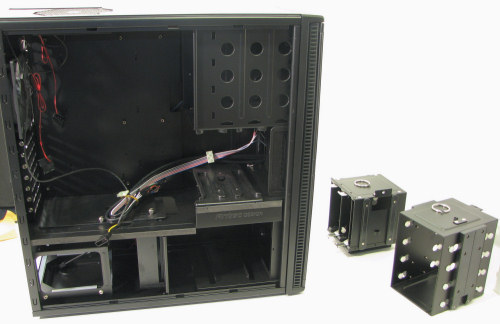 |
| Click to enlarge |
Unlike the P180 we reviewed earlier, the entire inside of the P182 SE is black - right down to the drive cages and motherboard mounting tray. To hold the hard drives, two separate removable cages are used. The top unit can contain two drives, each one in its own removable sled, and the bottom cage can hold four with vibration-dampening rubber grommets.
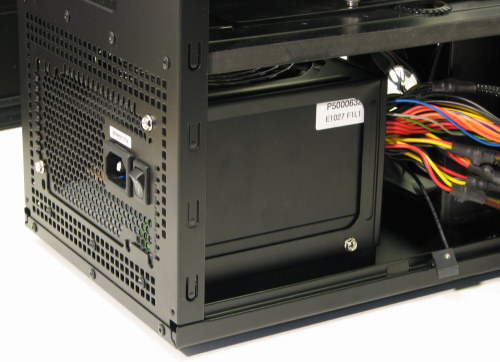 |
| Click to enlarge |
Each cage is guided securely in place along rails and held fast with a single thumbscrew. As for the power supply, it's held with a piece of metal with rubber along some of its edges that goes around three sides and then fastens with screws onto a platform underneath. Four more screws can go into the PSU itself in the back, regardless of which way the unit is oriented - a nice touch a lot of cheaper cases still have not implemented.
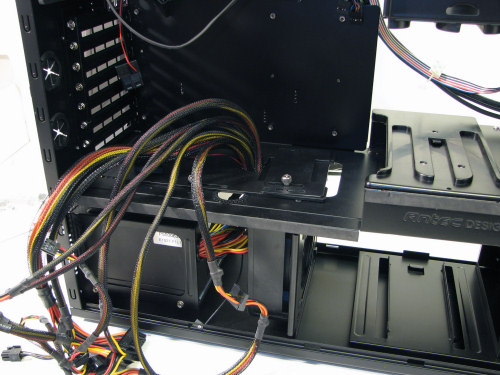 |
| Click to enlarge |
Our Zalman PSU's plethora of cables still all fit through the collapsible opening, but longer power supplies might require the removal of the fan in this bottom section. For the longest power supplies, the entire plate that the fan mounts onto can be taken out. The handy sliding cover serves to keep the cabling neat, and simultaneously it segregates the different airflow zones of the case; unfortunately it's still a bit flimsy in its construction and use. There are actually two holes in the cover, one for the power supply cables and one for cabling to go to the lower hard drive cage. Both can be opened and closed individually.










63 Comments
View All Comments
Anorax - Sunday, July 15, 2007 - link
Hi Joshua. Just read this review. To be honest this is a fairly average review. What sets the P182 series apart from other cases is specifically the ability to route cables behind the backplate the motherboard is fixed to and between the rear case cover. There are cable ties, fixing points, and access holes for just this purpose.By removing the cable mess from the area over the motherboard you give the case a much better airflow and therefore lower overall ambient temperatures. You say the review was rushed but there would have been little if extra time involved in quickly routing the cables behind the keyboard.
So really you have defeated the whole purpose for using this case in the first place. Sorry but a little more attention to detail next time would be good.
Anorax - Sunday, July 15, 2007 - link
The word *keyboard should read *motherboard.Jodiuh - Friday, April 13, 2007 - link
Why must they continue to put the bottom 120 in the middle of the case? My HDD's will roast 10C hotter in that config as opposed to blowing cool air OVER the HDD's. :(Leth - Tuesday, May 22, 2007 - link
You can move the middle mounted 120mm fan to the front of the case if you wish, or even add an extra so you have two 120mm's in the bottom part. Having two gives you a push/pull airflow setup for hd's mounted in the bottom ;)afilis - Friday, April 13, 2007 - link
Correct me if i'm wrong but i haven't seen anywhere in the review if you can fit a pair of 8800gtx with both cages installed, as these gfx cards are extra long...??bamacre - Thursday, April 12, 2007 - link
Don't get me wrong, this case, and others have a lot of features not found in a Dell, but take a peek inside a Dell XPS 410 or Precision 390.Dell's assembly for the optical drives is one major thing that no other cases I have seen have tried to duplicate. The Precision 390 case design even allows for the changing of the optical drives to be rotated so that the system can be used as a desktop or a tower, and this change takes literally 90 seconds. It is just so incredibly easy to add or replace an optical drive in a Dell because of the case design.
This complaint is personal but would apply to any of us who would only want one or two internal. Again, Dell's design for hard drives is so simply and yet so brilliant. Two pull-out plastic enclosures. No screws needed. Pull one out, slide in a hard drive, and pop it back in. It is just so easy, and this is definitely something that some case makers could easily implememnt.
Reference:
http://www.majortoker.com/images/xps410a_04.jpg">http://www.majortoker.com/images/xps410a_04.jpg
The hard drive enclosures are located on the bottom left and center.
JarredWalton - Friday, April 13, 2007 - link
Already done http://www.anandtech.com/systems/showdoc.aspx?i=28...">months ago. A quote you'll probably agree with:That said, the XPS 410 chassis is not designed to house dual GPUs or a variety of other options. It's a good all-in-one system for a non-enthusiast (i.e. people that don't care about overclocking), but it's not inexpensive either.
bamacre - Friday, April 13, 2007 - link
Yeah, I remember the article, it was very good actually.But what I meant to say was that other case-makers should implement some of the nice features that Dell has in their cases.
JarredWalton - Friday, April 13, 2007 - link
Ah, I see... maybe they want to avoid patent infringement lawsuits? ;)One possibility is that they want to make sure their cases are more compatible. You have to be able to fit anything from an old P3 up through the latest Core 2 Quad or X2 in a standard ATX case. Part of the reason Dell cases can be easy to work with is that they are often designed for a specific, proprietary motherboard. I'm still surprised we haven't seen more screwless designs that actually work well, however.
bamacre - Friday, April 13, 2007 - link
Yes, patent infringement is certainly a possibility.And yes, Dell has an edge in that they are specifically made for their motherboards. They've done a good job utilizing that, too. One particular nice feature is that blue thing that gives physical support for heavier video cards, to prevent them from bending over time. I work on a lot of Dells, I've replaced everything possible in the xps 410 and Prec 390, except for the case/mobo/psu. They are just so damn easy to work with. Even replacing the cpu is a breeze.